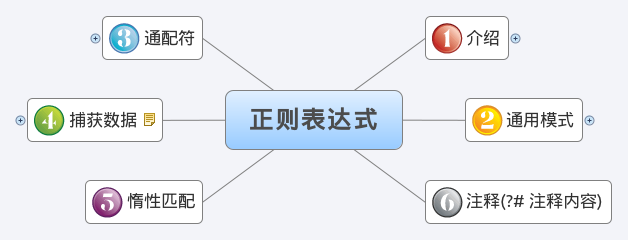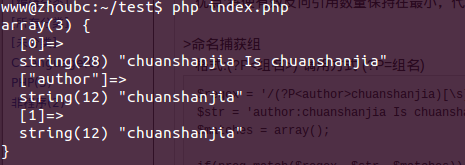
$regex = '/^http:\/\/([\w.]+)\/([\w]+)\/([\w]+)\.html$/i';
$str = 'http://www.youku.com/show_page/id_ABCDEFG.html';
$matches = array();
if(preg_match($regex, $str, $matches)){
var_dump($matches);
}
echo "\n";
preg_match中的$matches[0]將包含與整個模式匹配的字符串。
使用"#"定界符的代碼如下.這個時候對"/"就不轉義!
$regex = '#^http://([\w.]+)/([\w]+)/([\w]+)\.html$#i';
$str = 'http://www.youku.com/show_page/id_ABCDEFG.html';
$matches = array();
if(preg_match($regex, $str, $matches)){
var_dump($matches);
}
echo "\n";
¤ 修飾符:用於改變正則表達式的行為。
我們看到的('/^http:\/\/([\w.]+)\/([\w]+)\/([\w]+)\.html/i')中的最後一個"i"就是修飾符,表示忽略大小寫,還有一個我們經常用到的是"x"表示忽略空格。
貢獻代碼:
$regex = '/HELLO/';
$str = 'hello word';
$matches = array();
if(preg_match($regex, $str, $matches)){
echo 'No i:Valid Successful!',"\n";
}
if(preg_match($regex.'i', $str, $matches)){
echo 'YES i:Valid Successful!',"\n";
}
¤ 字符域:[\w]用方括號擴起來的部分就是字符域。
¤ 限定符:如[\w]{3,5}或者[\w]*或者[\w]+這些[\w]後面的符號都表示限定符。現介紹具體意義。
{3,5}表示3到5個字符。{3,}超過3個字符,{,5}最多5個,{3}三個字符。
* 表示0到多個
+ 表示1到多個。
¤ 脫字符號
^:
> 放在字符域(如:[^\w])中表示否定(不包括的意思)——“反向選擇”
> 放在表達式之前,表示以當前這個字符開始。(/^n/i,表示以n開頭)。
注意,我們經常管"\"叫"跳脫字符"。用於轉義一些特殊符號,如".","/"
通配符(lookarounds):斷言某些字符串中某些字符的存在與否! lookarounds分兩種:lookaheads(正向預查 ?=)和lookbehinds(反向預查?<=)。 > 格式: 正向預查:(?=) 相對應的 (?!)表示否定意思 反向預查:(?<=) 相對應的 (?<!)表示否定意思 前後緊跟字符
$regex = '/(?<=c)d(?=e)/'; /* d 前面緊跟c, d 後面緊跟e*/
$str = 'abcdefgk';
$matches = array();
if(preg_match($regex, $str, $matches)){
var_dump($matches);
}
echo "\n";
否定意義:
$regex = '/(?<!c)d(?!e)/'; /* d 前面不緊跟c, d 後面不緊跟e*/
$str = 'abcdefgk';
$matches = array();
if(preg_match($regex, $str, $matches)){
var_dump($matches);
}
echo "\n";
>字符寬度:零 驗證零字符代碼
$regex = '/HE(?=L)LO/i';
$str = 'HELLO';
$matches = array();
if(preg_match($regex, $str, $matches)){
var_dump($matches);
}
echo "\n";
打印不出結果!
$regex = '/HE(?=L)LLO/i';
$str = 'HELLO';
$matches = array();
if(preg_match($regex, $str, $matches)){
var_dump($matches);
}
echo "\n";
能打印出結果!
說明:(?=L)意思是HE後面緊跟一個L字符。但是(?=L)本身不占字符,要與(L)區分,(L)本身占一個字符。
捕獲數據 沒有指明類型而進行的分組,將會被獲取,供以後使用。 > 指明類型指的是通配符。所以只有圓括號起始位置沒有問號的才能被捕捉。 > 在同一個表達式內的引用叫做反向引用。 > 調用格式: \編號(如\1)。$regex = '/^(Chuanshanjia)[\w\s!]+\1$/';
$str = 'Chuanshanjia thank Chuanshanjia';
$matches = array();
if(preg_match($regex, $str, $matches)){
var_dump($matches);
}
echo "\n";
> 避免捕獲數據 格式:(?:pattern) 優點:將使有效反向引用數量保持在最小,代碼更加、清楚。 >命名捕獲組 格式:(?P<組名>) 調用方式 (?P=組名)
$regex = '/(?P<author>chuanshanjia)[\s]Is[\s](?P=author)/i';
$str = 'author:chuanshanjia Is chuanshanjia';
$matches = array();
if(preg_match($regex, $str, $matches)){
var_dump($matches);
}
echo "\n";
運行結果

惰性匹配(記住:會進行兩部操作,請看下面的原理部分)
格式:限定符?
原理:"?":如果前面有限定符,會使用最小的數據。如“*”會取0個,而“+”會取1個,如過是{3,5}會取3個。
先看下面的兩個代碼:
代碼1.
<?php
$regex = '/heL*/i';
$str = 'heLLLLLLLLLLLLLLLL';
if(preg_match($regex, $str, $matches)){
var_dump($matches);
}
echo "\n";
結果1.

代碼2
<?php
$regex = '/heL*?/i';
$str = 'heLLLLLLLLLLLLLLLL';
if(preg_match($regex, $str, $matches)){
var_dump($matches);
}
echo "\n";
結果2

代碼3,使用“+”
<?php
$regex = '/heL+?/i';
$str = 'heLLLLLLLLLLLLLLLL';
if(preg_match($regex, $str, $matches)){
var_dump($matches);
}
echo "\n";
結果3

代碼4,使用{3,5}
<?php
$regex = '/heL{3,10}?/i';
$str = 'heLLLLLLLLLLLLLLLL';
if(preg_match($regex, $str, $matches)){
var_dump($matches);
}
echo "\n";
結果4

$regex = '/
^host=(?<!\.)([\d.]+)(?!\.) (?#主機地址)
\|
([\w!@#$%^&*()_+\-]+) (?#用戶名)
\|
([\w!@#$%^&*()_+\-]+) (?#密碼)
(?!\|)$/ix';
$str = 'host=192.168.10.221|root|123456';
$matches = array();
if(preg_match($regex, $str, $matches)){
var_dump($matches);
}
echo "\n";
特殊字符 特殊字符 解釋 * 0到多次 + 1到多次還可以寫成{1,} ? 0或1次 . 匹配除換行符外的所有單個的字符 \w [a-zA-Z0-9_] \s 空白字符(空格,換行符,回車符)[\t\n\r] \d [0-9]